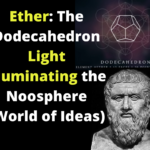The Egyptian Pyramid also symbolically represents this idea of the mundane tree. Its apex is the mystic link between heaven and earth, and stands for the root, while the base represents the spreading branches, extending to the four cardinal points of the universe of matter. It conveys the idea that all things had their origin in spirit — evolution having originally begun from above and proceeded downward, instead of the reverse, as taught in the Darwinian theory. In other words, there has been a gradual materialization of forms until a fixed ultimate of debasement is reached. This point is that at which the doctrine of modern evolution enters into the arena of speculative hypothesis. Arrived at this period we will find it easier to understand Haeckel’s Anthropogeny, which traces the pedigree of man “from its protoplasmic root, sodden in the mud of seas which existed before the oldest of the fossiliferous rocks were deposited,” according to Professor Huxley’s exposition. We may believe man evolved “by gradual modification of a mammal of ape-like organization” still easier when we remember that (though in a more condensed and less elegant, but still as comprehensible, phraseology) the same theory was said by Berosus to have been taught many thousands of years before his time by the man-fish Oannes or Dagon, the semi-demon of Babylonia. We may add, as a fact of interest, that this ancient theory of evolution is not only embalmed in allegory and legend, but also depicted upon the walls of certain temples in India, and, in a fragmentary form, has been found in those of Egypt and on the slabs of Nimroud and Nineveh, excavated by Layard.
But what lies back of the Darwinian line of descent? So far as he is concerned nothing but “unverifiable hypotheses.” For, as he puts it, he views all beings “as the lineal descendants of some few beings which lived long before the first bed of the Silurian system was deposited.” He does not attempt to show us who these “few beings” were. But it answers our purpose quite as well, for in the admission of their existence at all, resort to the ancients for corroboration and elaboration of the idea receives the stamp of scientific approbation. With all the changes that our globe has passed through as regards temperature, climate, soil, and — if we may be pardoned, in view of recent developments — its electromagnetic condition, he would be bold indeed who dare say that anything
Page 155
in present science contradicts the ancient hypothesis of ante-Silurian man. The flint-axes first found by Boucher de Perthes, in the valley of the Somme, prove that men must have existed at a period so remote as to be beyond calculation. If we believe Buchner, man must have lived even during and before the glacial epoch, a subdivision of the quaternary or diluvial period probably extending very far back in it. But who can tell what the next discovery has in store for us?
Now, if we have indisputable proof that man has existed so long as this, there must have been wonderful modifications of his physical system, corresponding with the changes of climate and atmosphere. Does not this seem to show by analogy that, tracing backward, there may have been other modifications, which fitted the most remote progenitors of the “frost-giants” to live even contemporaneously with the Devonian fishes or the Silurian mollusks? True, they left no flint-hatchets behind them, nor any bones or cave-deposits; but, if the ancients are correct, the races at that time were composed not only of giants, or “mighty men of renown,” but also of “sons of God.” If those who believe in the evolution of spirit as firmly as the materialists believe in that of matter are charged with teaching “unverifiable hypotheses,” how readily can they retort upon their accusers by saying that, by their own confession, their physical evolution is still “an unverified, if not actually an unverifiable hypothesis.” The former have at least the inferential proof of legendary myth, the vast antiquity of which is admitted by both philologists and archaeologists; while their antagonists have nothing of a similar nature, unless they help themselves to a portion of the ancient picture-writings, and suppress the rest.

Moe is the founder of GnosticWarrior.com. He is a father, husband, author, martial arts black belt, and an expert in Gnosticism, the occult, and esotericism.






